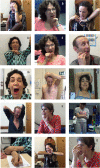Sensory Tricks in Pantothenate Kinase-Associated Neurodegeneration: Video-Analysis of 43 Patients
- PMID: 31745482
- PMCID: PMC6856458
- DOI: 10.1002/mdc3.12842
Sensory Tricks in Pantothenate Kinase-Associated Neurodegeneration: Video-Analysis of 43 Patients
Abstract
Background: Sensory tricks are a classic hallmark of primary dystonia and result in specific maneuvers that temporarily improve dystonic posture or movement. Pantothenate kinase-associated neurodegeneration (PKAN) is a progressive neurological disorder that courses with prominent dystonia. Although previously described, sensory tricks are considered to be rare in PKAN.
Cases: We reviewed videotaped motor examinations of 43 genetically confirmed patients with PKAN in order to identify and classify sensory tricks. All patients presented some feature of dystonia. Eighteen (42%) had one or more well-structured sensory tricks. Twelve different sensory tricks were identified, eight typical and four atypical (forcible motor): four in cervical dystonia, four in limb dystonia, three in oromandibular dystonia, and one in blepharospasm. A characteristic forcible motor maneuver for oromandibular dystonia (previously described as the "mantis sign") was present in 8 patients.
Conclusions: Sensory tricks are common in PKAN, particularly for oromandibular dystonia. The mantis sign may be a useful clue for the diagnosis.
Keywords: PKAN; alleviating maneuvers; secondary dystonia; sensory tricks.
© 2019 International Parkinson and Movement Disorder Society.
Conflict of interest statement
The pilot study was supported by Fundació Marató TV3 (Research Grant nos. 20143130 and 20143131); no specific funding was received for this secondary analysis. The authors report no conflicts of interest.
Figures
References
-
- Ochudło S, Drzyzga K, Drzyzga LR, Opala G. Various patterns of gestes antagonistes in cervical dystonia. Parkinsonism Relat Disord 2007;13:417–420. - PubMed
-
- Thomas M, Hayflick SJ, Jankovic J. Clinical heterogeneity of neurodegeneration with brain iron accumulation (Hallervorden‐Spatz syndrome) and pantothenate kinase‐associated neurodegeneration. Mov Disord 2004;19:36–42. - PubMed
Publication types
LinkOut - more resources
Full Text Sources


